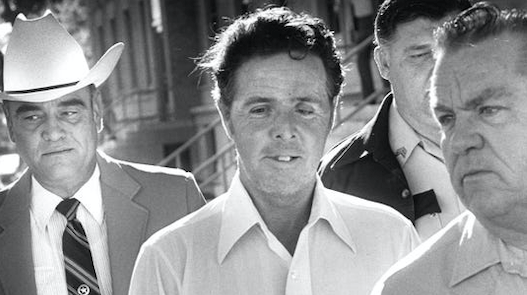
On October 31, 1979, a driver headed north on I-35 near Georgetown, Texas and noticed a body laying in between the highway and the nearby access road. Upon discovering the body, the driver drove to the nearest gas station where he called the Williamson County Sheriff’s Department. When the officials arrived, the body was discovered to be a young nude female, with the only item of clothing and physical evidence being a pair of orange socks. These orange socks would be the only identifier for the young female throughout her investigation.1
Henry Lee Lucas, a man neglected and abused by his mother at a young age, began his life of crime early on in his life. There wasn’t anything he had been charged and arrested for in the past that would amount to the vile acts he would confess to in future years, including confessing to the murder of the Orange Socks girl.2

Leading up to his confession, Lucas had been arrested for the possession of a firearm by a felon and taken to the Montague County Jail. While in custody, Lucas decided he would hand in a previously written statement that entailed the confessions to several murders.3 Within two days of his arrest in Montague County, he began confessing to slews of killings from all over the country. These confessions would, many years later, get him ultimately convicted of ten homicides, and he would be a very strong suspect in over one hundred other homicides.4 Lucas said that there were sixty murders he had added to his confession as a means to get back at the police for arresting him on the firearm charge, which he thought to be a charge made-up by the police. Although Lucas had confessed to many killings, it was his June 1983 confession to the Orange Socks murder that would get him convicted and lead him to become involved in the 1989 court case Lucas v. State of Texas.5
In 1989, the Lucas v State trial commenced, in which Lucas was tried for the murder and rape of the unidentified female in Williamson county, better known as the “orange socks girl.” During the court’s proceedings, psychiatrists, state witnesses, as well as Lucas were put on the stand to testify and be questioned. As the trial came to a close, the defense brought in an expert psychologist and psychiatrist to give their testimony regarding the evaluations they had previously conducted on Lucas. The expert psychologist Dr. Tom Kubiszyn conducted his psychological evaluations on February 28 and 29 of 1984, lasting about seven hours each, and from these evaluations Kubiszyn testified that Lucas, “has an IQ in the low average or normal range, with strong feelings of inadequacy and inferiority, of evasiveness and suspiciousness.”6 Kubiszyn also diagnosed Lucas as being schizophrenic while having some qualities of a sociopathic disorder. The expert psychiatrist Dr. Jay Fogelman had conducted five interviews with Lucas where he gained information from Lucas about himself. From these interviews Fogelman came to the same conclusion as Kubiszyn in that Lucas was suffering from some form of schizophrenia that needed treatment, as well as that he may have an antisocial personality. Both Kubiszyn and Fogelman said that Lucas was not only suffering from the previously mentioned schizophrenia, but that he was also a dangerous individual based on his history of previous violence.7
When the issue of his right to an attorney arose for Lucas, he tried to claim that he was denied his right to counsel guaranteed to him in the sixth amendment. But it was also noted that he did not go against the statements given by the state witnesses and understood that he would not receive counsel and did not want an attorney present. Later, against the advice of his various attorneys to remain silent and implement discretion, Lucas chose to do the opposite and he had appeared “…to have been determined to speak to the authorities desiring his attention. In what may be best termed a single-minded purpose, he appears to have rejected his right to remain silent and put the State to its burden of proving a particular crime…..appellant made what can only be termed a conscious practice of informing on himself as to crimes which, up until that point in time, remained unsolved.” In this same scenario, Lucas claimed he only wanted to talk about where the bodies were, as long as someone listened and was determined to only confess to his “criminal conduct” based on his desires and terms.8

As the trial continued, Lucas described the incident in his words. Lucas described the Jane Doe has having refused to engage in intercourse with him and of having tried to jump out of the moving vehicle. Lucas claimed she grabbed hold of the steering wheel, and that he grabbed her in a motion to try and stop her attempt to escape, while she fought against him. This action caused by the deceased was thought to Lucas as a sufficient reason to handle her in such a manner since it could’ve resulted in a car accident and in his own demise. The court did not find this evidence and information useful in the incident that the deceased was trying to provoke violence from Lucas or to incite him. Despite this information and the details coming solely from Lucas, who would’ve been present for the crime, the court did not find any information that corroborated that Lucas had any desire or intention to release Jane Doe alive. Based on this notion, it was derived that Lucas killed the deceased not based on the passion in the heat of the moment, but from careful calculation.9
Based on all the relevant information and testimony given by the state’s witnesses, expert psychiatrist and psychologists, as well as Lucas’ own testimony, the court reached a verdict in the Lucas v. State trial. The verdict reached was guilty on the capital murder charge on Lucas, and he was given a life sentence in prison for his crime. Being as Lucas was being convicted on a capital murder charge—the highest offense one can commit—meant that he was being sentenced to death and would be put on death row.10 Lucas was to serve out his sentence in a facility in Texas for the remaining time of his life.11
Going back to the years prior to his conviction, starting in 1983, around the time of his orange socks confession, Lucas had been interviewed by around 600 different law enforcement agencies. Through these interviews about open cases, police were gaining useful information, and cleared roughly 210 homicide cases. But since these case closures were directly attribute to Lucas, he began bragging about how he was the one getting cases close, not the law enforcement agencies.12 This combined attention and the fact that he believed he was exhibiting retribution against police on the “made-up” firearm charge, could’ve led to why he chose to confess to the orange socks murder and the hundreds of others.
Lucas remained on death row until 1998. At that time, the then-governor of Texas George W. Bush cited that there was a lack of evidence linking Lucas to the murder of the then unidentified “orange socks” woman other than his confession, and removed his death sentence. This was the only time governor Bush would allow such a situation to occur. Having his death sentence removed, but his life in prison sentence still intact, Lucas remained in prison until his death in 2001 from a heart attack.13

After significant investigation, interviews and verification through familial DNA testing, the unidentified woman, who was known as “Orange Socks,” was identified. In 2019, almost forty years after her brutal murder and rape, the individual was identified as being Debra Jackson, from Abilene, Texas, and she was only twenty-three years old at the time of her untimely death. It was believed that Jackson had left her home in 1977, two years prior to her interaction with Lucas, and was not initially reported missing by her family.14
- Lucas v. State, 791 S.W.2d 35 (Tex. Crim. App. 1989), 40. ↵
- Steven A. Egger, The Killers Among Us: An Examination of Serial Murder and Its Investigation (New Jersey: Prentice Hall, 1998), 169. ↵
- Lucas v. State, 791 S.W.2d 35 (Tex. Crim. App. 1989), 41. ↵
- Steven A. Egger, The Killers Among Us: An Examination of Serial Murder and Its Investigation (New Jersey: Prentice Hall, 1998), 11. ↵
- Gisli Gudjonsson PhD, “The making of a serial false confessor: The confessions of Henry Lee Lucas,” The Journal of Forensic Psychiatry, 10:2 (1999): 416-426, DOI: 10.1080/09585189908403693 418, 421. ↵
- Lucas v. State, 791 S.W.2d 35 (Tex. Crim. App. 1989), 43. ↵
- Lucas v. State, 791 S.W.2d 35 (Tex. Crim. App. 1989), 43. ↵
- Lucas v. State, 791 S.W.2d 35 (Tex. Crim. App. 1989), 49. ↵
- Lucas v. State, 791 S.W.2d 35 (Tex. Crim. App. 1989), 65. ↵
- Content Team. “Capital Murder – Definition, Examples, Meaning, Cases, and Sentences.” Legal Dictionary, (February 15, 2019). https://legaldictionary.net/capital-murder/. ↵
- Gajanan Mahita, “The Story Behind the Netflix Series ‘The Confession Killer,’” Time, (December 6, 2019). https://time.com/5745028/the-confession-killer-henry-lee-lucas-netflix/. ↵
- Steven A. Egger, The Killers Among Us: An Examination of Serial Murder and Its Investigation (New Jersey: Prentice Hall, 1998), 172, 207. ↵
- Gajanan Mahita, “The Story Behind the Netflix Series ‘The Confession Killer,'” Time, (December 6, 2019). https://time.com/5745028/the-confession-killer-henry-lee-lucas-netflix/. ↵
- Abigail Arredondo, “Who Was Debra Jackson, the ‘Orange Socks’ Cold Case Victim?” KVUE, (August 8, 2019). https://www.kvue.com/article/news/local/who-was-debra-jackson-the-orange-socks-cold-case-victim/269-e7073ddd-14a5-4221-b223-27ae29f7f2c7. ↵



63 comments
Guadalupe Altamira
Amazing informative article about Henry Lee Lucas. I know very little about him and only knew he was arrested for a firearm rather than the murders he’s committed. It’s disgusting how he didn’t show any remorse to any victim and just told people like it was nothing to him. It’s clear that the abuse he received as a child affected him psychologically. The way he was bragging and “showing off” his killing really fed his ego.
Alyssa Leos
Right from the beginning I could tell that Lucas was almost like a narcissist. It’s insane how he could just kill 60 more people all because he was arrested for a firearm charge and has no remorse. It’s heartbreaking that nobody was able to identify Jackson until 40 years later. Hopefully her soul is finally able to rest. This was a very well written article!
Maria Luevano
I had never heard about Henry Lee Lucas before, so reading this article was very interesting, and learning more about his story. It is shocking that it took 40 years to identify a body, it makes you wonder how this is possible? Henry is another example out of many criminals and murders of how mental illness can cause someone to do terrible things. Mia, you did an amazing job writing this article it kept me intrigued the entire time.
Carlos Hinojosa
This article just shows that the most random of people can be the most heartless and spineless of all people and deserve to go to the deepest parts of hell. The fact that he confessed to so many murders just out of spite for getting arrested for something else just boggles my mind. I mean the fact that they didn’t charge him for most of them simply because they didn’t believe him also boggled my mind. Anyways, a very good article and I hope to read more from you.
Irene Urbina
Great article! I have never heard of Henry Lee Lucas which made me interested in reading this article. This article made a little mention about Lucas’s abuse and neglect from his mother, although it was mentioned only once and not detailed, it shows that this piece of information had a great influence on Lucas. Lucas definitely had so many problems that had not been treated that led him to talk about his cases without any regret and saying that he is closing all the cases. That is why it is important that children are in a healthy, loving environment, and that people take care of their mental health.
Edward Cerna
Although this article was so sad so read, it was still an amazing article as it tells the story of someone that was extremely troubled. It is crazy how he was able to get away with it for so long and also to feel no compassion about his killings. It is so sad that it took so long to discover the identity of Debra Jackson. This was a very amazing read as it kept me wanting to read more until the very end. I liked the pictures used in the article as it added greatly to the story.
Kimberly Rubio
It is sad that it took nearly 40 years to identify Debra Jackson. I am surprised that her family had not reported her missing sooner, though I know this is often the case with runaways. It is also rare that Texas, which is known for its high rate of capital punishments, would remove his death sentence. However, I understand George W. Bush’s perspective as the number of cases he confessed to versus the evidence was suspicious.
Madeline Emke
I found this article interesting because I had never heard of Henry Lee Lucas before reading this article. I was confused as to what a serial confessor was because I knew a serial killer was someone who had killed at least three people, but a serial confessor is apparently someone who confesses to multiple crimes. I was a little shocked that it took forty years to uncover the identity of Debra Jackson.
Donte Joseph
I had never heard of Henry Lee Lucas but am glad to have learned more about him while reading this article. The fact that he went around killing people without even batting an eye is very gross to me. I understand that some people cannot feel remorse but why goes as far as intentionally inflicting pain upon others. This is a big reason that I believe mental health should be taken more serious.
Caroline Bush
Great article! Before reading this article I had never heard about Lucas so from the beginning I was hooked. It is scary to think that men like that walk among everyday citizens without anyone realizing it. This man was a psychopath with his lack of emotion and his unfiltered rage. This article did a great job providing the details of the case and how horrible this man truly was. Great article!